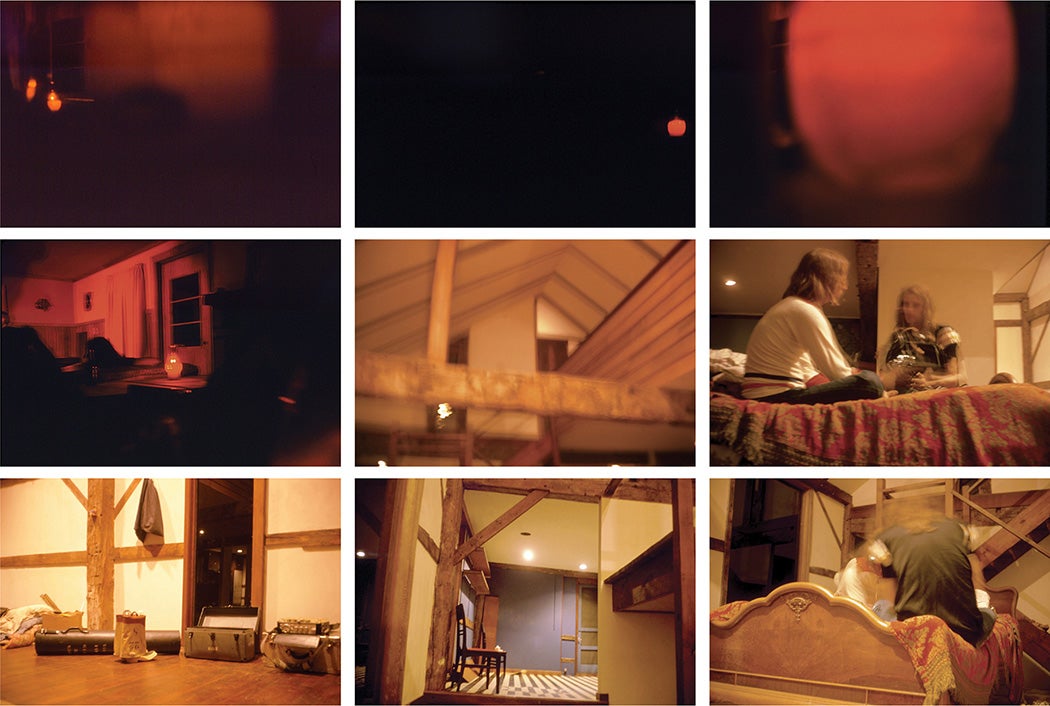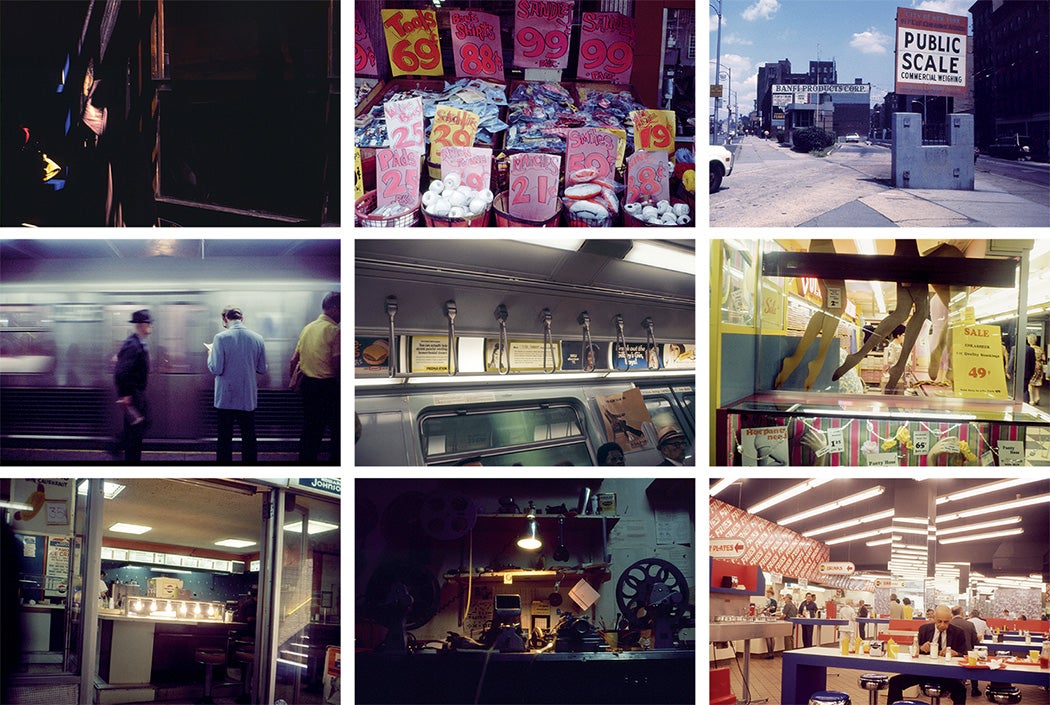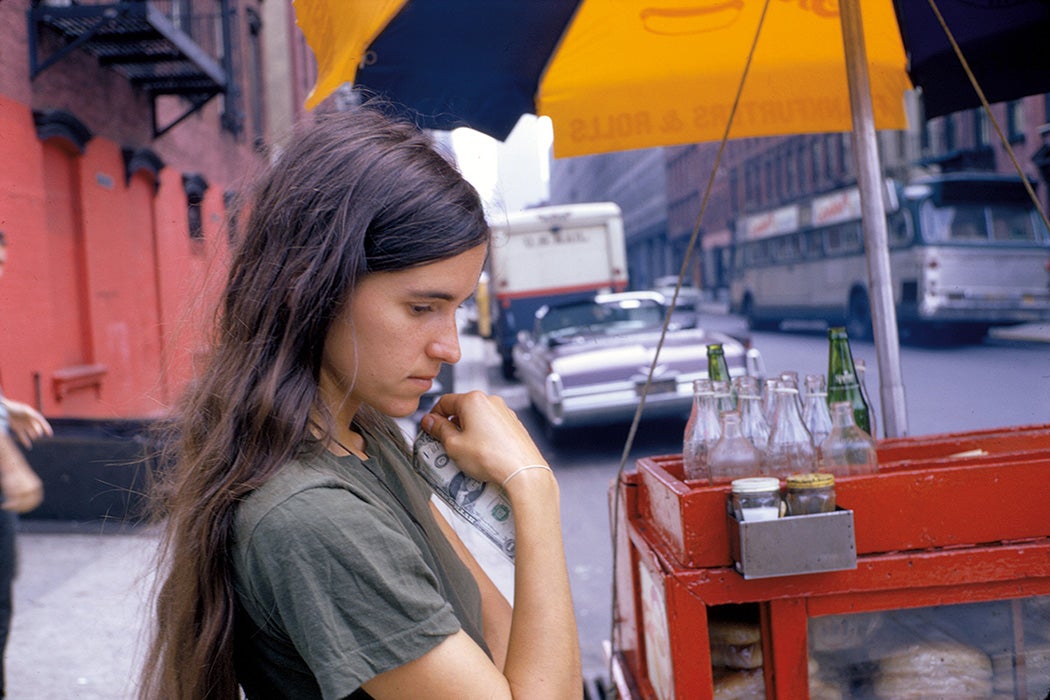I started working on this article before COVID-19 became a global interruption to everyday life. Now, when we’re asked to stay home as much as possible, Memory serves as both an inspiration and a painful reminder of how full a day could be: parties with friends, trips to the bar or bookstore, busy city streets, casual encounters and road trips. So many aspects of normal life are on hold right now, and it can be useful to be reminded of what we took for granted. But Mayer’s work demonstrates the value in attending to our everyday life, even if it’s confined to smaller square footage. What happens outside the window, the noises we hear from other apartments, the photographs we find on our corkboard or in our phones, the meals we’re cooking, the shows we’re watching, the words we read online or in books—these are all part of life and demonstrate how larger structures of gender, politics, and economics affect even these small moments. They make up our memories too, if we pay attention.
How do we remember what we’ve lived through? In July 1971, poet and artist Bernadette Mayer wanted to find out. She decided to document an entire month, in order “to record all of the human mind that mine could see” (“Bring It Here”). She called the project Memory. Each day, Mayer exposed a roll of 35 mm slide film and wrote in a corresponding journal. The result was over 1,100 snapshots developed from the film and a text that took six hours for her to read aloud. The work was exhibited in 1972 at Holly Solomon’s gallery, where 3-by-5-inch color prints were placed on the wall to create a grid, while the full six-hour audio recording of Mayer’s journal played. The audio was later edited for a book published in 1976 by North Atlantic Books, but the full text and images were never published together until this year, by the art book publisher Siglio Books. Memory is a testament to how Mayer synthesized various influences and poetic forms to create her unique approach to politically and socially conscious art, and remains a singular investigation into how much of our lives can, and cannot, be documented.

I first encountered Memory in 2016, when reprints of the slides were shown in a similar grid-like fashion at the Poetry Foundation. The images are a consistent size, but they depict a wide range of subjects, from city streets, buildings, signs, diners, rooftops, subways, demolition, and construction, to more intimate scenes of laundry in the sink, dishes drying, a pot cooking on the stove, friends lying in bed or bathing, portraits of her partner and herself, parties, TV screens, and many images of large blue skies. There are also frequent trips to small towns, with their stray cats and clapboard houses, tall trees, and flowering bushes. Some images are underexposed, others play with multiple exposures, and the overall palette is dominated by shades of blue and black.
Weekly Newsletter
The text that accompanies the images is similarly wide-ranging, describing the events captured by the images as well as what went unphotographed. The first day, July 1, has some line breaks, but the vast majority of the work is in long prose blocks. Mayer’s work is a hybrid of forms and influences which, as Maggie Nelson describes it, “folds the visionary/imaginative capacities of poetry in with the unpretentious, life-affirming notation of the present moment—its details, its desires, and the sound of whatever social or interior speech happens to be at hand.” In Memory, the present moment is represented by energetic run-on sentences that incorporate dreams, automatic writing, and the actions and words of her companions, as well as her own thoughts:
I was looking out the window around at things anne took a shower lay down on the bed & made a phone call the sky looked like this: profiles anne on the bed holding up a piece of white paper the phone in her other hand, we worked, read through the book aloud violet revolution & all all in hoarse men’s voices fast I massaged anne’s neck. We decide to go to the movies, ed tells us we may have a room in a sound studio in massachusetts the next day we find out it’s political, we are on contract, will take the book to the printer’s ourselves, we drop off anne at prince street & drive up 1st ave to see carnal knowledge ed took this, we waited on a line to see it, we blended in to see it, when we saw how red the screen of the theater was…
This section of Memory, from the second day of the project, describes and expands on some of the photographs from the same day. There are four photographs of a woman (likely fellow poet Anne Waldman) holding up a piece of paper and talking on the phone, followed by images of a group waiting in line for a movie and the red screen of the theater. The lengthy sentences, shifting tenses, and descriptions of various activities add movement to the static images, which can only convey changes when multiple photos of the same scene are presented: When Anne’s hand holding the paper moves from above her head to below, we imagine that movement between the photographs. The combination of text and images allows for a fuller record of each day. Together, they convey the collaborative, communal world Mayer worked within.

Bernadette Mayer was born in May 1945 in Brooklyn. She graduated from the New School for Social Research in 1967, and in 1971, at 26, she was documenting life in New York City as a young artist and poet. Just as the sentences in Memory blend, hesitate, and repeat, Mayer herself blended in and overlapped with multiple groups of artists and writers in New York. Before Memory, she worked closely with a wide array of artists and poets as the coeditor of the art magazine 0 to 9 with Vito Acconci (her sister’s husband) from 1967-69. The magazine published artists Sol LeWitt, Adrian Piper, Dan Graham, and Robert Smithson; dancer/poet Yvonne Rainer; composer, performance artist, and poet Jackson Mac Low; as well as poets associated with the second-generation New York School like Kenneth Koch, Ted Berrigan, and Clark Coolidge, and Language poets like Hannah Weiner.
Recording of Mayer reading the final text of Memory. Bernadette Mayer Papers. MSS 420. Special Collections & Archives, UC San Diego.
The influence of the first generation of New York School poets, such as John Ashbery, Frank O’Hara, and James Schuyler, can been seen in Mayer’s naming of friends and specific streets, her conversational tone, and the mundane activities Memory records (waiting in line, going to the movies, dropping off friends). In an article on the second generation of the New York School, Daniel Kane summarizes the difference between the two groups: “O’Hara’s poems are akin to a dinner party where each individual is distinct, recognizable, and charming. In the second generation world, the party has turned much, much wilder, to the point where it is at times difficult to figure out who is who in all the commotion.” Kane argues that the anti-academic style of the second generation, as well as its interest in communal production and publication as community-building, meant they have not received the same critical reception or recognition. But scholars are increasingly recognizing the second generation of the New York School as an important movement in its own right. As Kane writes:
…they were extending, enriching, and complicating a tradition, as opposed to merely aping one. Such an achievement was realized via radical and politicized acts of collaboration, a working-class-inflected rhetoric in contrast to the stylized urbanity (and attendant queer camp) of their predecessors, and a welcome infusion of women’s writing and editing in a formerly male-dominated scene.
Mayer and Waldman were two such women whose importance to the second-generation lay in their writing, editing, and teaching. Memory often focuses on the experiences of being a woman, not only for Mayer herself, but also for the women around her:
This is Kathleen this is kathleen here is kathleen here is kathleen kathleen is here she’s doing the dishes why is kathleen doing the dishes why is she doing the dishes why the dishes why not the dishes kathleen doing the dishes she does them she did them last week she did them again she didnt do them right the first time why does she have to do them again do them again, she said. I’ll do them again there she is doing the dishes again look at her doing them she does them typewriter teletape tickertape typewriter tickertape tele-tape kathleen is doing the dishes she’s doing them again when will she finish when will she finish.
It’s clear Mayer’s influences go farther back than the first generation of the New York School. The excerpt above, for example, calls to mind Gertrude Stein. The repetition here is not merely descriptive; it makes us experience the monotonous nature of dishwashing while questioning the social and gender dynamics that led to Kathleen’s predicament: why is she always doing the dishes? Who is saying she didn’t do them right? The interruption of the typewriter suggests either Mayer’s own writing, or the writing Kathleen might like to do if she weren’t busy cleaning dishes, or perhaps it indicates the repetitive sound the dishwashing makes, dishes clinking like typewriter keys.

It’s obvious that the women of the New York School had different daily experiences, stereotypes, and pressures to face in their writing than their male counterparts. Mayer’s work, according to Nelson, helps us “understand how a phobia of ‘going too far’—of writing too much, of wanting too much, of transgressing the proprieties of economic, literary, and/or sexual structures we’ve infused with a particular morality—is often tied up with a paranoia about the voracious desires and the vexing capacities of the female body.”
In Memory, this voracious desire manifests in an appetite for documenting life itself:
One day I saw ed, eileen, barry, marinee, chaim, kay, denise, arnold, paul, susan, ed, hans, rufus, eileen, anne, harris, rosemary, harris, anne, larry, peter, dick, pat, wayne, paul m, gerard, steve, pablo, rufus, eric, frank, susan, rosemary c, ed, larry r, & david; we talked about bill, vito, kathy, moses, sticks, arlene, donna, randa, picasso, john, jack nicholson, ed, shelley, alice, rosemary c, michael, nick, jerry, tom c, donald sutherland, alexander berkman, henry frick, fred margulies, lui, jack, emma goldman, gerard, jacques, janice, hilly, directors, holly, hannah, denise, steve r, grace, neil, malevich, max ernst, duchamp, mrs. ernst, michael, gerard, noxon, nader, peter hamill, tricia noxon, ed cox, harvey, ron, barry, jasper johns, john p, frank stella & ted. I still see ed, barry, chaim, arnold, paul, rufus, eileen, anne, harris is away, I dont see rosemary, harris is away, anne, larry, peter occasionally, who’s dick?, pat, gerard is away, pablo is away, I still see steve, who’re eric & frank?, I still see rosemary c, ed, & david is a different one. It’s impossible to put things exactly as they happened or in their real order one by one but something happened that day in the middle of seeing some people & talking about some, something happened that day…
This excerpt takes the highly social nature of poems by the first generation New York School and exaggerates it so as to parody it. O’Hara and Schuyler would often mention the friends and artists they saw, but never in a list this long. O’Hara’s poems are often simplistically called “I do this, I do that” poems, but here it takes a long time to get to where “something” happens at all. The sheer size and length of Memory allows so much to be absorbed within it.
Bronwen Tate has looked specifically at long poems by women during this time period, and concludes that, “Unlike the brief lyric, which can be read and appreciated in a moment or two, the long poem works through deferral and delay, contrast and repetition, theme and variation. Its pleasures emerge from duration and accretion.” This interest in duration and accretion through repetition ties Mayer’s work with several of the performance artists she published in 0 to 9, among them Rainer, Piper, and Acconci. Other avant-garde artists had pursued repetitive and time-based works in the preceding decades: John Cage and Andy Warhol each stretched out their pieces to the point of tedium or boredom to make audiences uncomfortable or at least more aware of how their time was being spent.

Memory was Mayer’s first widely-received exhibition, and it paved the way for her later book-length projects, which continued their focus on the political and social roles she played, as well as time-based constraints. Midwinter Day, for example, concerned itself with a single day in December 1978 with the same intensity of detail, documenting a time in her life when she was a mother, living outside of New York. As C.D. Wright noted in the Antioch Review, Mayer’s work was a unique hybrid of forms:
While Bernadette Mayer’s book length Midwinter Day is rightly referred to as an epic, it rightly relies on lyrical interludes to render it proportional. And though this icy equinox in 1978 appears as ordinary as Lenox, Massachusetts, wherein the poem is set—in keeping with any truly articulated moment in any individual’s life at any point in space—it is that sui generis, that exalted.
Mayer affirms this point, and extends it further, to its political source: “i must say yes i did think that everyday life was good and important to write down because of our work with the committee for nonviolent action.” This emphasis on daily life was not only a poetic statement, it was a political one. If we value human life, then we should value what makes up a life. Dailiness, after all, does not mean smallness. In Mayer’s writing, the mundane is often explicitly related to the political. In the first day’s entry for Memory, she repeatedly mentions Attica prison as if refusing to let readers forget it (this was shortly before the riots), and later, in a trip to “the country,” she considers personal and communal ownership:
& well jealousy is all you own jealousy & some jalousie windows & I’ve brought in the dictionary as I’m into it & is it easy how easy questions run into each other into how questions run each other into great walls so a man in a yellow shirt looks at me he bends down he’s on my private property I didnt think I had one & I think we cannot swim are not allowed to swim in his stream I think we cannot own each other’s rights at all at least not me & him so what does he have to say I say these questions of private property always end in periods. They do.
The mention of “jalousie” suggests Alain Robbe-Grillet, who wrote a novel of the same name and whose name appears twice in Memory. Robbe-Grillet used repetition, fragmentation, and a focus on particular details to suggest psychological narratives and reveal the interiority of his characters, who were often struggling with relationships and gender dynamics. Memory uses similar disjunctive techniques and precise details to sketch a larger, ambiguous story. Here, the term “private property” seems to refer to both personal space and legal ownership, which leads Mayer to questions of land rights and human rights. These questions “run each other into great walls,” dividing humans from each other in reality, in metaphor, and in punctuation (rare for Mayer, and therefore emphatic).
Wright considers Midwinter Day an ode because “ode-time is thought-time as it occurs, not as later formulated.” Memory could similarly be considered an ode as well as an epic, not only because it documents thoughts as they occur, but because attention to detail can be in itself a form of praise. This exaltation of everyday life allows the lyric to punctuate the epic. In Mayer’s work, the small and ordinary rise to the level of heroic adventures.
In an introduction for the new Siglio edition of Memory, Mayer explains how, despite her best efforts, Memory left so much uncovered:
It’s astonishing to me that there is so much in Memory, yet so much is left out: emotions, thoughts, sex, the relationship between poetry and light, storytelling, walking, and voyaging to name a few. I thought by using both sound and image, I could include everything, but so far, that is not so. Then and now, I thought that if there were a computer or device that could record everything you think or see, even for a single day, that would make an interesting piece of language/information, but it seems like we are walking backward since everything that becomes popular is a very small part of the experience of being human, as if it were all too much for us.
The gaps in Memory are part of the experience of being human. Thankfully, we can’t remember or record everything that happens to us, at least not yet. And even if we could record all the facts, how would we add all the emotions, all the ways it felt to experience any given moment, how memories were triggered by certain smells, sounds, or sights? How would we describe what a given touch felt like, or how political or social conditions affected our experiences? It would take forever. If documenting your life requires documenting every detail, then your life would be consumed by the recording of it—you’d have to record your recording in the record and so on. In the end, the only way to experience all it means to be alive is to live.







